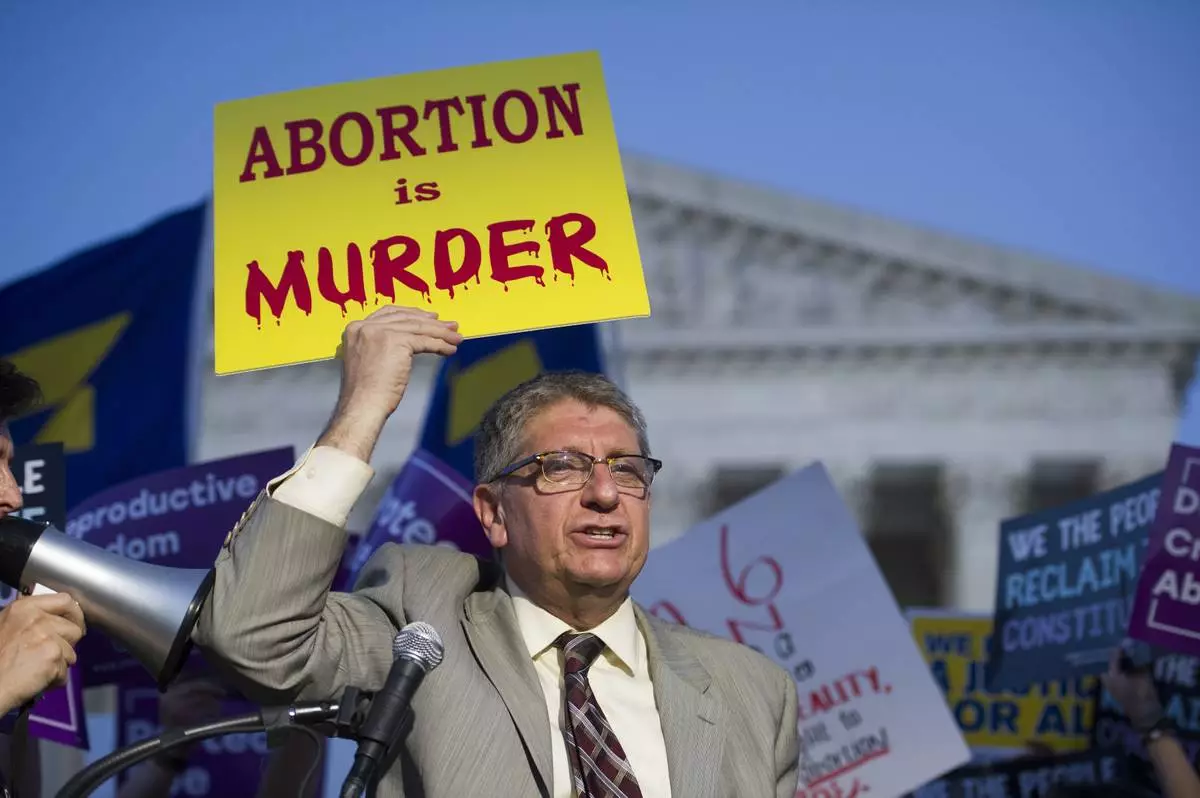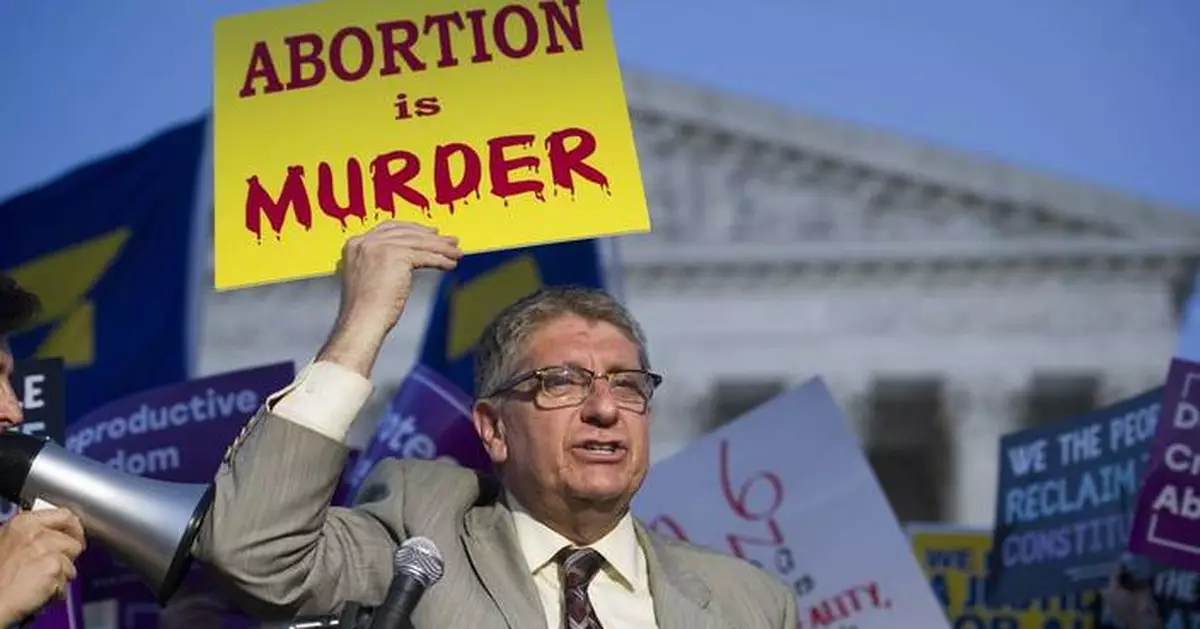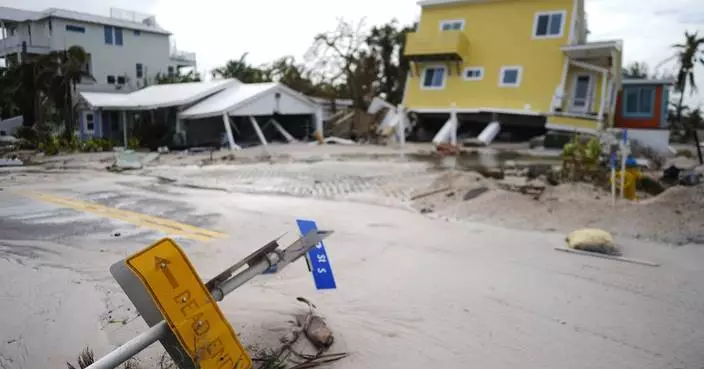An anti-abortion ad that aired during “ The View ” this past week and criticized the show's personalities was the most visible manifestation of a campaign that is making use of a federal law that forbids broadcasters from turning it down.
In the ad, a narrator says, “I am so sick of stupid celebrities and lying journalists,” while the screen shows pictures of “The View” host Whoopi Goldberg, her colleagues and other celebrities, including Taylor Swift, Oprah Winfrey, Robert DeNiro, Billie Eilish, Wolf Blitzer, Rachel Maddow and Dana Bash.
The ad compares the celebrities to Nazi leaders Joseph Goebbels and Leni Riefenstahl, criticizes the Americans for their so-called support of abortion rights and includes graphic pictures of aborted fetuses.
In a disclaimer that posted onscreen, ABC made clear it was holding the message at arm's length: “The following is a paid political advertisement, and the ABC television network is required to carry it by federal law. The advertisement contains scenes that may be disturbing to children. Viewer discretion is advised.”
Longtime anti-abortion activist Randall Terry is behind the ads. Terry is a fringe candidate for president who has qualified for the ballot in a dozen states as the standardbearer of the Constitution Party, a status that has enabled him to get airtime for his commercials.
Under Federal Communications Commission regulations, broadcast stations “are prohibited from censoring or rejecting political ads that are paid for and sponsored by legally qualified candidates,” a standard that Terry has met.
“This is the last bastion of free speech,” Terry said in an interview. “The only place that you can still have free speech is on a licensed station as a federal candidate.”
The FCC rule applies only to candidates, not political organizations, meet its criteria and doesn't apply to cable networks or web-based properties like podcasts. CNN, which is not required to show the ad and said it wouldn't meet its standards anyway, issued a statement calling it “outrageous, antisemitic and dangerous.”
Terry already has another ad — featured on his website but not yet on television — that specifically targets CNN's Jake Tapper.
“I'm not going to be the president,” Terry said. “I'm not delusional. The whole point of this is to cause Kamala's defeat.”
To that end, many of his ads are anti-Harris and, except for a brief printed message on the screen, don't even mention his candidacy. He has been running advertisements on a local level throughout the campaign, in each of the states where an abortion measure is on the ballot. A total of 40 local ads have been completed, along with a series of national advertisements, Terry said.
His target audience is people aged 50 to 80, an age group that would be most likely to watch broadcast television, who are likely Democratic voters, Catholics and Black.
Christian F. Nunes, president of the National Organization for Women, said she worries that the ads represent a manipulation of FCC regulations and are promoting hateful rhetoric.
“It's definitely concerning,” Nunes said. “No one should be able to use running for office as a free pass in order to spew hate speech.”
Terry is probably more attuned than any activist to the use of FCC rules to help spread his message, said Jack Goodman, a Washington lawyer and former general counsel of the National Association of Broadcasters. He's not aware of any efforts to change the regulations through the years.
The rules don't permit broadcasters to edit the advertisements for use of what may be considered shocking images or language; whether or not an ad can contain an obscenity, for instance, has not been tested in court, Goodman said. On his website, Terry's so-far unaired Tapper ad includes an obscenity, although he said he will likely use a cleaner version for television.
He doesn't object to the warnings that some stations have shown before his ads.
“They're doing what they feel is in the best interest of the station,” Terry said. “That's up to them. I can't fault them for that. Look, these are hard images to see.”
Nunes said she suspects the advertisements will backfire for Terry among many women, driving them to the polls to vote against what he's advocating.
David Bauder writes about media for the AP. Follow him at http://x.com/dbauder.

FILE - Operation Rescue founder Randall Terry protests in front of the Supreme Court in Washington, Monday, July 9, 2018. (AP Photo/Cliff Owen, File)
Denver (AP) — Investigators on Friday were trying to figure out what led to an elevator accident inside a former Colorado gold mine that killed a tour guide, injured four others and left 12 people trapped for hours at the bottom of the tourist attraction 1,000 feet (305 meters) beneath the surface.
The elevator was descending into the Mollie Kathleen Gold Mine near the town of Cripple Creek in the mountains near Colorado Springs on Thursday when the door malfunctioned around 500 feet (152 meters) beneath the surface, Teller County Sheriff Jason Mikesell said.
Victim Patrick Weier, 46, was a guide at the mine and a father from the nearby town of Victor, Colorado. The exact circumstances of his death were not disclosed, but the sheriff said he died because of the elevator's mechanical issue and not due to a medical issue.
Eleven other people, including two children, who were riding the elevator during the mishap were brought up with it following the accident. Four had minor injuries including back pain, neck pain and arm pain, the sheriff said.
Twelve adults from a second group were trapped for about six hours Thursday below ground while engineers made sure the elevator could be used. The group had access to water and used radios to communicate with authorities, who told them there was an elevator issue, Mikesell said.
They were hoisted up in groups of four over 30 minutes. Officials had been prepared to bring them up by rope if necessary.
Most people who were in the elevator when it malfunctioned were later taken to a local relief center where some got showers, new clothes and sandwiches, said Ted Borden, with the Community of Caring Foundation in Cripple Creek.
“It was still very raw, but there was some good camaraderie,” Borden said.
Elevator accidents at mines are extremely rare, said Steven Schafrik, a University of Kentucky associate professor of mining engineering. They have been used by the industry to carry people and material since the mid-1800s, he said, and modern elevators are equipped with fail-safe devices that prevent them from falling far if a cable breaks.
“They're just ridiculously safe,” Schafrik said of mining elevators.
He declined to comment directly on the Colorado accident.
Mikesell said the family that owns the mine had operated it for many years and worked to make it safe.
“Anytime you're dealing with machinery and a 1,000 foot level at the 500 feet level in a mine, there could be accidents," he said.
Mines that operate as tourist attractions in Colorado must designate someone to inspect the mines and the transportation systems daily, according to the state Division of Reclamation, Mining and Safety. Mikesell said he didn’t know the date of the last inspection at the Mollie Kathleen Mine. Records of the inspections weren’t immediately available online.
Changes to the elevator were made in 1988 after the mine came under new ownership, according to the mine's website. A second elevator that could carry nine people was suspended below the existing elevator, and a new motor was installed to accommodate the increased weight, the website says.
The accident was under investigation by local and state authorities along with the U.S. Mine Safety and Health Administration and the Occupational Safety and Health Administration.
The incident, which was reported to authorities at about noon, happened during the final week of the Mollie Kathleen Gold Mine season before it shuts down for the winter, Mikesell said.
The mine's owners issued a statement Friday expressing their condolences and thanking emergency responders. The mine will be closed until further notice, they said.
Cripple Creek is a town of about 1,100 in the Rocky Mountains southwest of Colorado Springs.
The mine opened in the 1800s and closed in 1961, but still operates tours. Its website describes a one-hour tour. It says visitors can see veins of gold in the rock and ride an underground tram.
A woman named Mollie Kathleen Gortner discovered the site of the mine in 1891 when she saw quartz laced with gold, according to the company’s website.
Brown reported from Billings, Mont. Associated Press writer Mead Gruver in Cheyenne, Wyoming, contributed to this report.

Emergency personnel stage outside the Mollie Kathleen Gold Mine in Cripple Creek, Colo., Thursday, Oct. 10, 2024, after one person died in an equipment malfunction during a tour of the mine according to the Teller County Sheriff's Department. (Arthur Trickette-Wile/The Gazette via AP)

A winch brings up trapped mine visitors Thursday, Oct. 10, 2024, at the Mollie Kathleen Gold Mine in Cripple Creek, Colo. (Arthur Trichett-Wile/The Gazette via AP)

First responders work the scene Thursday, Oct. 9, 2024, at Mollie Kathleen Gold Mine in Cripple Creek, Colo. (Arthur H. Trickett-Wile/The Gazette via AP)

A police officer moves a barrier for an emergency vehicle Thursday, Oct. 9, 2024, at Mollie Kathleen Gold Mine in Cripple Creek, Colo. (Arthur H. Trickett-Wile/The Gazette via AP)














